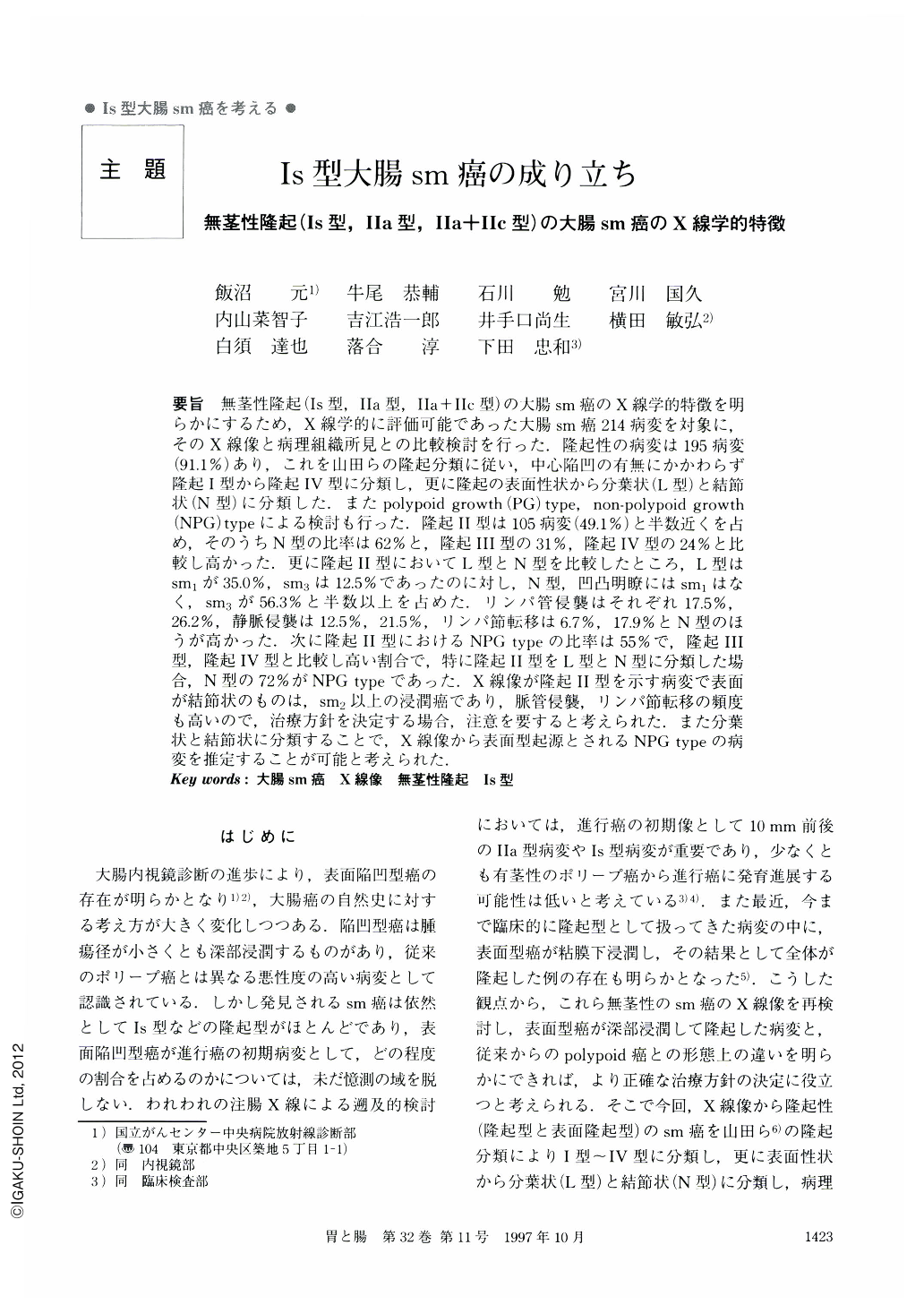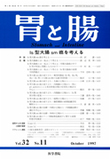Japanese
English
- 有料閲覧
- Abstract 文献概要
- 1ページ目 Look Inside
- サイト内被引用 Cited by
要旨 無茎性隆起(Is型,Ⅱa型,Ⅱa+Ⅱc型)の大腸sm癌のX線学的特徴を明らかにするため,X線学的に評価可能であった大腸sm癌214病変を対象に,そのX線像と病理組織所見との比較検討を行った.隆起性の病変は195病変(91.1%)あり,これを山田らの隆起分類に従い,中心陥凹の有無にかかわらず隆起I型から隆起Ⅳ型に分類し,更に隆起の表面性状から分葉状(L型)と結節状(N型)に分類した.またpolypoid growth(PG)type,non-polypoid growth(NPG)typeによる検討も行った.隆起Ⅱ型は105病変(49.1%)と半数近くを占め,そのうちN型の比率は62%と,隆起Ⅲ型の31%,隆起Ⅳ型の24%と比較し高かった.更に隆起Ⅱ型においてL型とN型を比較したところ,L型はsm1が35.0%,sm3は12.5%であったのに対し,N型,凹凸明瞭にはsm1はなく,sm3が56.3%と半数以上を占めた.リンパ管侵襲はそれぞれ17.5%,26.2%,静脈侵襲は12.5%,21.5%,リンパ節転移は6.7%,17.9%とN型のほうが高かった.次に隆起Ⅱ型におけるNPGtypeの比率は55%で,隆起Ⅲ型,隆起Ⅳ型と比較し高い割合で,特に隆起Ⅱ型をL型とN型に分類した場合,N型の72%がNPGtypeであった.X線像が隆起Ⅱ型を示す病変で表面が結節状のものは,sm2以上の浸潤癌であり,脈管侵襲,リンパ節転移の頻度も高いので,治療方針を決定する場合,注意を要すると考えられた.また分葉状と結節状に分類することで,X線像から表面型起源とされるNPGtypeの病変を推定することが可能と考えられた.
For the purpose of evaluating radiologic characteristics of the sessile colonic sm cancer (Is, Ⅱa, Ⅱa+Ⅱc types), the radiologic pictures and histopathological findings of 214 lesions of colonic sm cancer were analyzed. There were 195 protruding lesions (91.1%) that were classified into 4 types (type I through type Ⅳ) by the protrusion classification of Yamada et al and were subdivided by the surface shape into the lobular type (L type) and nodular type (N type). These lesions were analyzed using the classification of the polypoid growth (PG) type and non-polypoid growth (NPG) type. Almost half of all lesions were protruding type Ⅱ lesions (105 lesions, 49.1%) and 62% of which was the N type. The proportion of the N type in the protruding type Ⅱ was higher than those in the protruding type Ⅲ (31%) and type Ⅳ (24%). In the protruding type Ⅱ, 35% of the L type had sm1 and 12.5% had sm3 invasion, whereas none of the N type had sm1 and 56.3% had sm3 invasion. Incidences of lymphatic invasion, venuos invasion and lymph gland metastasis were higher in the N type than the L type as follows: (L type, N type respectively) lymphatic invasion (17.5%, 26.2%), venous invasion (12.5%, 21.5%) and lymph gland metastasis (6.7%, 20.4%). In the protruding type Ⅱ, incidence of NPG type was 55%, which was higher than those in the protruding type Ⅲ and Ⅳ, especially when the protruding type Ⅱ lesions were subdivided into the types N and L, 72% of the type N was the NPG type. The protruding type Ⅱ lesions with nodular surface by the radiologic examination were invasive cancer deeper than the sm2 and likely to have lymphatic and venous invasion and lymph node metastasis, therefore we should be careful to make treatment plans for these lesions. Classification of the lobular and nodular shapes would help to find NPG type lesions by the radiologic examination, which were regarded as superficial type origin.

Copyright © 1997, Igaku-Shoin Ltd. All rights reserved.


